新概念第一册 lesson 9~12 知识点(独家教案)
新概念英语一-1-36课语法知识点总结复习以及相应习题
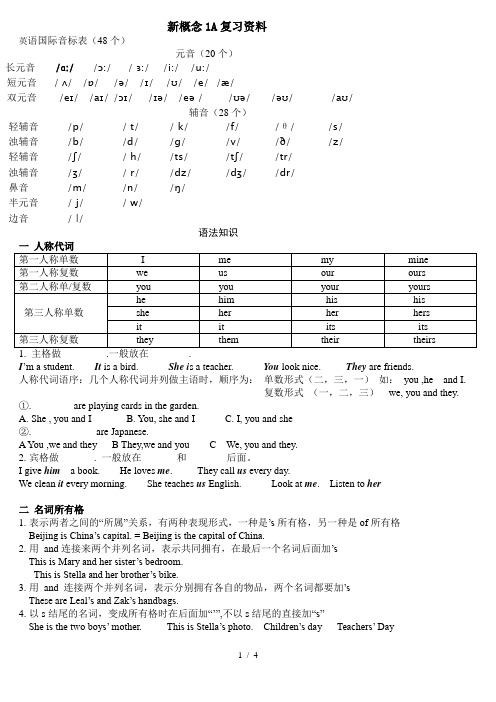
新概念1A复习资料英语国际音标表(48个)元音(20个)长元音/ɑ:/ /ɔ:// ɜ://i://u:/短元音/ ʌ//ɒ//ə//ɪ//ʊ//e//æ/双元音/eɪ/ /aɪ//ɔɪ/ /ɪə//eə / /ʊə//əʊ//aʊ/辅音(28个)轻辅音/p// t// k//f//θ//s/浊辅音/b//d/ /g//v//ð/ /z/轻辅音/ʃ// h//ts//tʃ//tr/浊辅音/ʒ// r/ /dz/ /dʒ//dr/鼻音/m//n/ /ŋ/半元音/ j// w/边音/ ǀ/语法知识I’m a student. It is a bird. She i s a teacher. You look nice. They are friends.人称代词语序:几个人称代词并列做主语时,顺序为:单数形式(二,三,一)如:you ,he and I.复数形式(一,二,三)we, you and they.①.________ are playing cards in the garden.A.She , you and IB. You, she and IC. I, you and she②. ____________ are Japanese.A You ,we and theyB They,we and youC We, you and they.2.宾格做_______. 一般放在_______和________后面。
I give him a book. He loves me. They call us every day.We clean it every morning. She teaches us English. Look at me. Listen to her二名词所有格1.表示两者之间的“所属”关系,有两种表现形式,一种是’s所有格,另一种是of所有格Beijing is China’s capital. = Beijing is the capital of China.2.用and连接来两个并列名词,表示共同拥有,在最后一个名词后面加’sThis is Mary and her sister’s bedroom.This is Stella and her brother’s bike.3.用and 连接两个并列名词,表示分别拥有各自的物品,两个名词都要加’sThese are Leal’s and Zak’s handbags.4.以s结尾的名词,变成所有格时在后面加“’”,不以s结尾的直接加“s”She is the two boys’ mother. This is Stella’s photo.Children’s day Teachers’ Day5 of形式的所有格The door of the room He is a friend of mine. He is a friend of my brother’s.三特殊疑问句引导词what什么答事物,who问谁来答人名,whose谁的表归属what color问颜色what’s …job问工作when问时间答时间,where 在哪答地点,which哪一任你选, how身体健康What nationality…问国籍What’s the matter..?问健康四冠词冠词有三个,不定冠词a/an, 定冠词the冠词用在名词的前面。
新概念第一册重点及重要句型1-12
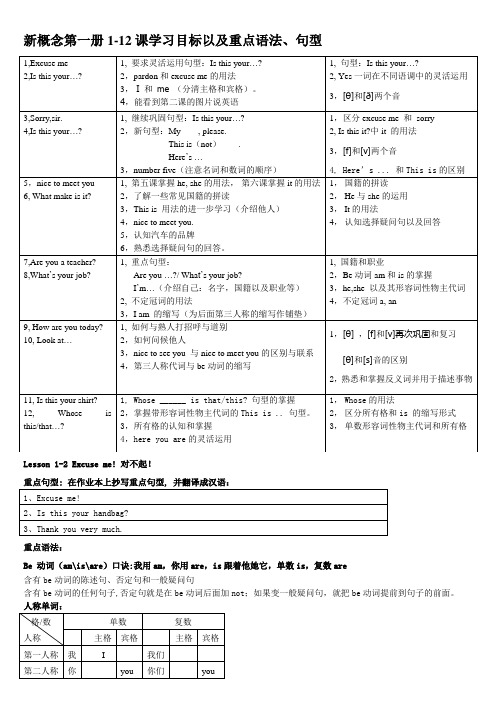
新概念第一册1-12课学习目标以及重点语法、句型Lesson 1-2 Excuse me! 对不起!重点句型: 在作业本上抄写重点句型, 并翻译成汉语:重点语法:Be 动词(am\is\are)口诀:我用am,你用are,is跟着他她它,单数is,复数are含有be动词的陈述句、否定句和一般疑问句含有be动词的任何句子,否定句就是在be动词后面加not;如果变一般疑问句,就把be动词提前到句子的前面。
人称单词:重点句型:重要语法1.祈使句:祈使句:主语通常不直接表示出来,其谓语动词用原型,也叫无主句。
表示命令、请求、建议、叮嘱等。
祈使句真正的主语是你,但省略了。
My umbrella and my coat please. 省略了动词和间接宾语的祈使句。
Keep off the grass! 请勿践踏草地!Help yourself! 请自己动手!某些祈使动词可以后跟and和另一个祈使动词,而不是后跟带to的动词不定式结构。
Come and see this goldfish.Go and buy yourself a new pair of shoes. 去给自己买双新鞋吧。
Wait and see. 等着瞧吧。
2.倒装句:here is 是简单的倒装句,be 动词放在here 的后面,这个句式就可以成为简单的倒装句式。
My ticket is here. 我的票在这。
Here is my ticket. / Here's my ticket.3.状态句之一:某物是某物在英语句子中,有一种句子表述的是静态的内容,只说明状态,没有动作:1).This is my handbag 这是我的手提包2).Is this your umbrella? 这是你的雨伞吗?3).He is my friend .他是我的朋友.Lesson 5 & 6 Nice to meet you. 很高心见到你。
新概念英语第一册讲义(完整版)

新(一)讲课步骤一上课(起立问好)1.自我介绍;2.介绍新(一)分三期学完, 本期从第1—48课,全册分三期学完;3.宣读《学生守则》;强调安全及纪律性;二正课部分1. 单词讲解:先让学生逐个起来诵读单词,学生读一个老师讲一个;教师对单词讲解并拓词.单词完先由老师领读(一升一降),然后再找学生带读、齐读。
2. 语法:在黑板上标明“语法”与“语法内容”讲解语法须标明各项内容名称,如“定义”“构成,步骤”等。
语法讲解后领学生做“课堂语法练习题”(或利用练习册语法题部分)或汉译英。
3. 课文:听录音(合着书)回答课题中的问题,要求学生将答案写在书上。
分析课文的内容,划出本课的语法现象(短语、句子)用符号●标出,称为语法符号。
抽词组并对课文中的专有名词(人名、地名)标出音标。
学生齐读或学生分角色朗读课文。
三副课部分1.单词讲解(同正课部分):此部分灵活掌握,如单词较少或补充内容不多,可与正课单词放在一块讲解。
处理课后练习和课课练。
2.语法讲解.四做练习1. 副课填空题:当堂必须全部完成,对答案;2. 句型题要求:A 较简单的题,须说明步骤、技巧。
B 较难的题,须把题型板书到黑板上,再说明做题步骤、技巧。
C 如句型题中出现新的语法现象,须将语法讲解清楚,带着学生做题。
D 句型题根据上课具体情况安排,数个至全部在课堂上由学生完成,其余题或典型题留成作业。
五作业:学生应准备三个本,(两个作业本AB,一个听写本)1.课文(正课)背写一遍→家长签字。
收改;2.单词(正课+副课)带音标抄3遍。
汉语一遍收改(前48课第一期,后两期可省去);3.课后练习题(句型题)做在本子上,前5个或一半,收改;4.课课练与本课对应练习完成。
收改;(其中难题在第四部分上课解决)。
5.单词、课文在下次课上分别听写、默写,100分者在听写本上扣章。
6.奖励方法:听写得连续5个一级棒,换一个小博士, 一期结束,看谁得最多有奖品;六其他:1.收测试卷费,订课课练答案;2.严格遵守“喝茶”及“考试、考勤”制度;3. 试卷考完后利用课堂最后的时间进行讲解,考试内容较多的分次讲解。
Lesson12指示代词(课件)新概念英语第一册
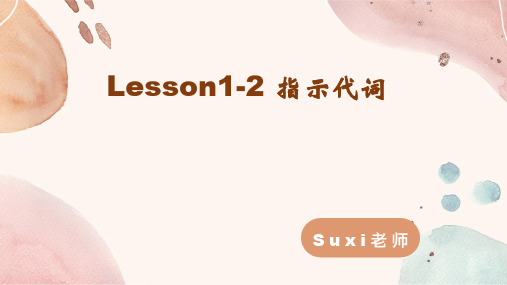
肯否定句回答
故事发展前序:
小羊苏西邀请小猪佩奇到家里坐客。晚饭后,小猪佩奇回家了,小羊苏西收拾着自 个家里卫生,却发现有个很精致的猪猪钱包落在了自家沙发上,小羊苏西这连忙给 小猪佩奇打电话并询问道……接下来,诡异的事情发生了……
(肯定句变疑问句)
Is this your schoolbag?
1.没有人称: Be动词放句首,其余照 抄加问号(?) 2.有人称: Be动词放句首,第一 人称(I)变第二人称 (you),其余照抄加问 号(?)
小试牛刀:
1.This is my wallet.(肯定句变一般疑问句)
__Is_t_h_is__y_o_ur__w_a_l_le_t?_____________________
This is an eraser.
That’s a book.
肯定句的转换
肯定句转变为否定句:
“二踢”:
1. “有球踢球”:
is(肯定)变is not(否定)
isn’t
2.“没球踢头”(that): That is=That’s (缩写)
“有球踢球” (留头发,合体) “没球踢头” (留头发,合体)
10.Is this your cap?(做肯定回答) ___Y_e_s_,_i_t__is_.__________________________
11.Is this your scarf?(做否定回答) ___N__o_,_i_t__is_n_’__t_. ______________________
8.Is this your raincoat?(做否定回答) ___N_o_,__i_t _i_sn__’__t._______________________
新概念英语第一册lesson9-10

New Words
tall 高的 young 年轻的 fat 肥胖的 Short 矮的 Old 老的 Thin 瘦的
New Words
hot 热的 busy 忙碌的 dirty 脏的
cold 冷的 lazy 懒得 clean 干净的
复习知识点: 人称代词
taxi driver n 出租汽车司机
air hostess 空中小姐
postman 邮递员
nurse 护士
mechanic 机械师
hairdresser 理发师
housewife 家庭主妇
milkman 送牛奶的人
句型练习
What is your job? 你是做什么工作的?
What nationality are you ? 你是哪个国家的?
How are you today ? I’m very well ,thank you .
And you ? I’m fine. Thanks.
How is Tony? He is fine .
How is Emma ? She is very well ,too.
Nice to see you , too, Steven .Goodbye .
Goodbye ,Helen . Nice to see you.
Translate the following into English
史蒂文:你好,海伦 海 伦: 你好,史蒂文 史蒂文:你今天好吗? 海 伦: 很好,谢谢你。你好吗? 史蒂文:很好,谢谢。 史蒂文:托尼好吗? 海 伦: 他很好,谢谢。埃玛好吗? 史蒂文:她也很好,海伦。 史蒂文:再见,海伦。见到你真高兴。 海 伦: 我见到你也很高兴,史蒂文。再见。
新概念第一册第9-12课课件

[ɔ:] 发这个音的字母和字母组合a aw al or oor a: water
aw:draw strawberry
al:ball wall
or:horse corn fork or short
oor:floor door 根据发音规则,找出发[ɔ:]的1个单词写在后面的横线上。 1.tall bird bread poor 2.idea chair sport hare
they them
Chant :
主格代词顺口溜:
我是I ,你是You ;
男他He ,女她She ,动物的它是It; 我们We ,你们You ,他们They. Who are you ?
The end !
book [buk] 书 pencil ['pensəl] 铅笔
boy [bɔi] 男孩
girl [gə:l] 女孩 they [ðei] 他们/她们/它们 are [a:] be动词,是 student ['stju:dənt] 学生
• [u]发这个音的字母和字母组合o oo u • o:woman wolf • oo:look good book foot wood • u:bull bullet • 根据发音规则,选出与其它单词元音发音 不相同的单词。 • 1.mouth book look pull • 2.push tape sugar foot • 3.wood kind wolf bull • 4.bullet wood cook name
shirt.blouse.coat.dress.skirt.suit
=
Whose is that …?
Teacher : Is this shirt____? Tim’s Dave : Perhaps it is, sir. Tim’s _____white. shirt’s
新概念英语第一册lesson 9-10

HELEN:
Hi, Steven.
STEVEN:
How are you today?
HELEN:
I'm very well, thank
you. And you?
STEVEN:
I'm fine, thanks.
How is Tony?
HELEN:
He's fine, thanks.
How's Emma?
What’s Tom like? He’s very fat. 3、英语中形容词作定语时一般置于名词之前。
Lesson 10 Look at…
fat/fæ t/ 胖的 Look at that man. He is fat.
woman ['wJmən]女人 复数 women
thin [θIn]瘦的 Look at that woman. She is thin.
史蒂文:再见,海伦。见到你真 高兴。 海 伦:我见到你也很高兴,史 蒂文。再见。
我来讲故事
情景替换:
Rose: 你好,Jack。 Jack: 你好,Rose. Rose: 你今天好吗? Jack: 很好。谢谢你。你好吗? Rose: 很好,谢谢。 Jack: 你爸爸好吗? Rose:他很好,谢谢。你妈妈呢? Jack: 她也很好。 Rose:再见,Jack.见到你很高兴。 Jack:我见到你也很高兴,Rose. 再见。
Rose: Hello,Jack。 Jack: Hi,Rose. Rose: How are you today? Jack: Fine,thank you. And you? Rose: I’m very well, thanks. Jack: How is your father? Rose:He is fine,thanks.
新概念第一册教案完整版

Lesson 1 Excuse me!教学重点1、辨析:Excuse me。
和I’m sorry.的用法区别。
2、代词:人称代词和物主代词总表、主格和宾格的区别、四个指示代词、代词与be动词的使用搭配及其缩写形式。
3、语气:陈述句变一般疑问句,及其肯定回答。
4、句型:-Is this your…?-Yes, it is.教学步骤1、引入话题。
2、让学生描述图片,中英结合.3、听一遍音频,掌握大意。
4、生词解读,纠正发音(详见课本)。
5、提出问题:Whose handbag is it?看一遍视频,解答问题.6、精讲课文,板书和笔记.7、再听一遍音频,逐句跟读。
8、总结本课重点,让学生标注。
9、布置作业:练习册,背课文和单词。
引入话题:Ok,I have a question。
我有一个问题,看看谁能回答上来。
有谁注意到我刚进门的时候说的第一句话了么?What is it?哪句话?No one?没有人注意么?啊,我说的第一句话是:Excuse me, may I have your attention, please?Let's have our class. 对不起,请大家注意,我们要上课了。
这里的第一句话:Excuse me就是我们新概念英语第一课的标题,那么我们今天要讲的这则小故事到底是什么呢?Well,today’s story is about a handbag。
啊,今天我们来讲一个关于手提包的故事.Ok, now, please open your books and turn to page one. 请大家打开书翻到第1页。
Look at here,there are many pictures, right? 啊,这里有许多图片。
So,how many pictures are there,who can tell me? 谁能告诉我有几幅图?Yes, very good,seven pictures。
新概念第一册第9课 (共34张PPT)

10.young---adj. 年轻的,年幼的
Ex: a young boy ( 一个年幼的孩子) a young tree ( 一棵幼小的树) a young teacher / man …
11. busy---adj. 忙碌的,热闹的,繁华的 ex: a busy day
a busy teacher I am busy . Are you busy? Look at the busy bee. The bee is busy .
• You have to believe in yourself. That's the secret of success. 人必须相信自己,这是成功的秘诀。
•
The woman is thin . She is a thin woman .
3.tall ---adj. 高的(细而高,多指树和人) ex: a tall boy
The boy is tall . Look at the
ex: a short man Look at the short man .
My mum isn’t tall , she is short . 反义词 : tall
语:
• —Nice to meet you, too!
• —Good morning! 早上好! 认识你我也很高兴。
• —Good morning! /Morning! • —Nice to see you! 见到
早上好!
你很高兴。 (再次见面)
• —Good afternoon! 下午好! • —Nice to see you, too! 见到你我也很高兴。
Lesson 9 How are you today ?
新概念英语第一册Lesson9-10笔记(语法点+配套练习+答案)

1、单词分类;
int.
adv.
adj.
v.
hello
hi
thanks
goodbye
how
today
well
fine
see
2、课文复习
三、课文重点
重点
练习
look at sb. / sth.看(强调动作)
see sb. / sth.看到(强调结果)
__Look at___that dog!快看那条狗!
He isfine.对划线部分提问:How is he?
She isvery well.对划线部分提问:How is she?
3.与how有关的特殊疑问词
how old
多大(年纪)
how many
多少(可数)
how far
多远
how tall
多高
how much
多少(不可数)
how often
多久一次
4.句型转换
肯:The man isbusy.
否:The man is not busy.
一疑:Is the man busy?
答:Yes, he is. / No, he isn’t.
特:How is the man?
5.选择题
肯:The box isheavy.
否:The box is not heavy.
表语:用来描述主语状态或特征,名词或形容词可做表语
She is tall.
He is thin.
We are young.
It is happy.
The man is strong.
Lesson9192(课件)新概念英语第一册(1)

14. Ask me if Jenny will see Ian today? Will Jenny see Ian today?
He’s going to move tomorrow. be going to do 计划、打算做某事。
I’ll miss him. = I will miss him. I miss home very much. He missed the train yesterday. I miss you because I missed you.
of the room. 他们把课桌移到了房间的左边。
miss /mis/ v. 想念,思念
1)想念,思念 eg. We will miss you if you move.
如果你搬家了,我们会想你的。 I really miss my hometown. 我真的很想念我的家乡。 2)错过 We missed the bus. 我们错过了那辆公车。
• -He didn’t want to leave this house. • -No, he didn’t, but his wife did! 反意疑问句: -He didn’t go to school yesterday, did he? -No, he didn’t.(是的,他没去。)
neighbour /5neib[/ n. 邻居
eg. He and I are neighbours. 他和我是邻居。
neighbourhood 四邻,邻近地区 eg. This is a quiet neighbourhood.
新概念英语第一册Lesson112课件(共34张PPT)
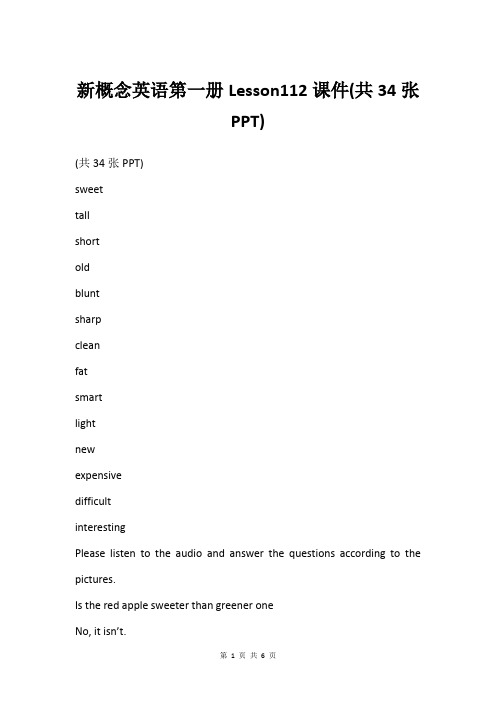
新概念英语第一册Lesson112课件(共34张PPT)(共34张PPT)sweettallshortoldbluntsharpcleanfatsmartlightnewexpensivedifficultinterestingPlease listen to the audio and answer the questions according to the pictures.Is the red apple sweeter than greener oneNo, it isn’t.The red apple is as sweet as the green one.Is the man shorter than the womanNo, it isn’t.The man is as short asthe woman..Is the record player on the left more expensive than the record player on the rightNo, it isn’t.The record player on the left is not as expensive as the record player on the right.Is the ... than the...No, ... isn’t. ... is (not) as ... as...Is the ... than the...No, ... isn’t. ... is (not) as ... as...Is the ... than the...No, ... isn’t. ... is (not) as ... as...Is the ... than the...No, ... isn’t. ... is (not) as ... as...Is the ... than the...No, ... isn’t. ... is (not) as ... as...Is the ... than the...No, ... isn’t. ... is (not) as ... as...Is the ... than the...No, ... isn’t. ... is (not) as ... as...Mr. Brown和Mrs. Brown在汽车专卖店挑选汽车,Mr.Brown看中一款标价150000的车,要比另一辆100000的车好,他们决定分期付款买下这辆车。
新概念英语第一册知识点讲解和归纳

36. fall asleep 入睡
37. again and again再三地,反复地
38. wake up 醒来,叫醒
39. instead of 代替
40. look over 检查
41. take exercise运动
12.from与to多表示方向,前者意为“从……”,后者意为“到……”。如:from one to ten, (go) to school/ bed/ work.
另外,以下这些短语也必须掌握。如:on duty, after breakfast, at night, at the door, in the middle, in the sky, on one’s bike等。
6.help sb. (to) do sth./help sb. with sth.意为“帮助某人做某事”,前者用不定式作宾补,后者用介词短语作宾补,二者可以互换。如:Let me help you find it.(L42)/Let me help you with it.
7.What about…?/How about…?意为“……怎么样?”是用来询问或征求对方的观点、意见、看法等。about为介词,其后须接名词、代词或V-ing等形式。如:What/How playing chess?
4.One…, the other…/One is…and one is…意为“一个是……;另一个是……”,必须是两者中。如:One is red and one is grey.(L50)或 One is red,, the other is grey.
5.Let sb. do sth. 意为“让某人做某事”,人后应用不带to的动词不定式,其否定式为Don’t let sb,do sth.,或Let sb. not do sth. 另外,Let’s 与Let us的含义不完全相同,前者包括听者在内,后者不包括听者在内,如:Let’s go for a walk./Let us try once more, please.
新概念英语第一册1-12课知识点
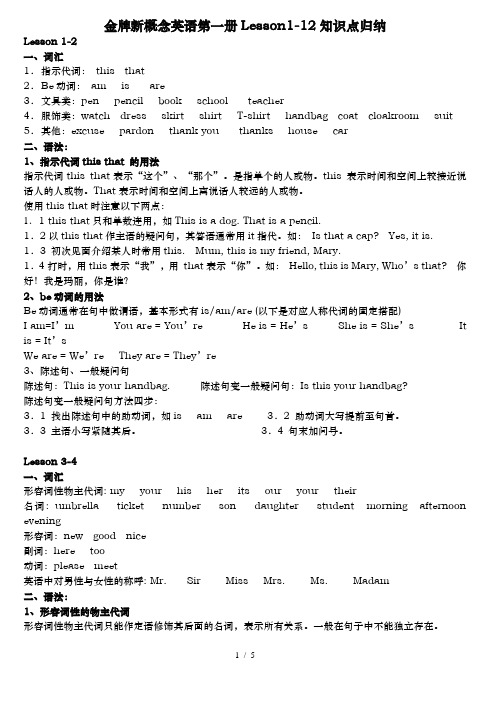
金牌新概念英语第一册Lesson1-12知识点归纳Lesson 1-2一、词汇1.指示代词:this that2.Be动词:am is are3.文具类:pen pencil book school teacher4.服饰类:watch dress skirt shirt T-shirt handbag coat cloakroom suit 5.其他:excuse pardon thank you thanks house car二、语法:1、指示代词this that 的用法指示代词this that表示“这个”、“那个”。
是指单个的人或物。
this 表示时间和空间上较接近说话人的人或物。
That表示时间和空间上离说话人较远的人或物。
使用this that时注意以下两点:1.1 this that只和单数连用,如This is a dog. That is a pencil.1.2以this that作主语的疑问句,其答语通常用it指代。
如:Is that a cap? Yes, it is.1.3 初次见面介绍某人时常用this. Mum, this is my friend, Mary.1.4打时,用this表示“我”,用that表示“你”。
如:Hello, this is Mary, Who’s that? 你好!我是玛丽,你是谁?2、be动词的用法Be动词通常在句中做谓语,基本形式有is/am/are (以下是对应人称代词的固定搭配)I am=I’m You are = You’re He is = He’s She is = She’s It is = It’sWe are = We’re They are = They’re3、陈述句、一般疑问句陈述句:This is your handbag. 陈述句变一般疑问句:Is this your handbag?陈述句变一般疑问句方法四步:3.1 找出陈述句中的助动词,如is am are 3.2 助动词大写提前至句首。
朗文外研社新概念英语第一册第5节(Lesson9—Lesson10)课件

The key:
A :你好,汤姆,很开⻓⻓到你。 Hello,Tom, nice to meet you. B:你好呀,莉莉,你都好吗? Hi,Lily, how are you? A:我过的⻓般,我家的⻓狗⻓病了。(sick形容词,病了) Just so so. My dog is sick. B:(听到这事⻓)我很抱歉呀!它现在还好吗?(now副词,现 在)
What is up ?(美国常用)
How is Tony? He's fine,thanks. How's Emma? She's very well,too.
经典句型:
How are you today? I'm very well,thank you. And you? I'm fine,thanks.
1
Lesson 9
How are you today?
how[hau]
How far? How long? How come? = Why?
How much? How many?
adv. 怎样(特殊疑问词)
多远的路? 多久的时间?或⻓度? 为什么?
多少钱(多少的量)? 多少个(询问数量)?
how far is your house? How long does it take to get to your house? How come you are there? =Why are you there?
年轻人 青年 老老少少
Tom is an old head on the young shoulders. 汤姆真是少年⻓成。
Lesson 10 Look at ...?
busy['bizi]
新概念第一册英语全面语法总结(K12教育文档)

(完整word版)新概念第一册英语全面语法总结(word版可编辑修改) 编辑整理:尊敬的读者朋友们:这里是精品文档编辑中心,本文档内容是由我和我的同事精心编辑整理后发布的,发布之前我们对文中内容进行仔细校对,但是难免会有疏漏的地方,但是任然希望((完整word版)新概念第一册英语全面语法总结(word版可编辑修改))的内容能够给您的工作和学习带来便利。
同时也真诚的希望收到您的建议和反馈,这将是我们进步的源泉,前进的动力。
本文可编辑可修改,如果觉得对您有帮助请收藏以便随时查阅,最后祝您生活愉快业绩进步,以下为(完整word版)新概念第一册英语全面语法总结(word版可编辑修改)的全部内容。
新概念英语第一册1—72课语法点总结1.物主代词●2.人称代词3.Be动词Be动词在一般现在时的三个变形:am, is, areBe动词在一般过去时的两个变形:was, were●注意: Be动词要根据主语的变化而变化。
4.一般疑问句定义:一般疑问句是指可以用Yes或者No回答的句子。
肯定句变为一般疑问句:若一个肯定句中存在Be动词am, is, are,则直接将Be动词提前,结尾加问号.若一个肯定句中存在情态动词,则直接将情态动词提前,结尾加问号.若一个肯定句中存在实义动词,则直接在句首加助动词do/does/did,实义动词变原形,结尾加问号.注意:一般疑问句一般读为升调.例:Are you a teacher?你是一名老师吗?肯定回答:Yes, I am. 否定回答:No, I am not。
Do you like English?你喜欢英语吗?肯定回答:Yes, I do。
否定回答:No, I don’t.5.特殊疑问句定义:不能用Yes或者No回答的句子。
构成:特殊疑问词 + 一般疑问句特殊疑问词:what(什么), when(何时), where(何地), who (谁), whom(谁宾格), whose(谁的), which(哪个), why(为什么), how(怎么样)口诀:非常八加一6.不定冠词a/an若单词是以“a, e, i, o"四个元音开头,其前面选用“an";若单词是以元音字母“u”开头,视情况而定。
- 1、下载文档前请自行甄别文档内容的完整性,平台不提供额外的编辑、内容补充、找答案等附加服务。
- 2、"仅部分预览"的文档,不可在线预览部分如存在完整性等问题,可反馈申请退款(可完整预览的文档不适用该条件!)。
- 3、如文档侵犯您的权益,请联系客服反馈,我们会尽快为您处理(人工客服工作时间:9:00-18:30)。
Catch you later 待会儿见
Farewell 一添路加顺风内容
添加内容
Have a nice day 祝你一天过的愉快
All the best 祝一切都好
Ta ta for now 再见 Have fun 玩的开心
添加 See you later =see you 再见 内容 Good luck 祝你好运
添加
How many/ how much/how oft内e容n/ how old/ how soon/how long...
添加内容
添加 内容
II. Vocabulary
● well [wel] adj. 身体好
【用法】well表示身体好时是形容词,其它都是副词,修饰动词、形容词、其它副词。
She is every well. 她身体很好。
see off (到机场、火车站等)为某人送行
see you later= see you!再见 ❷ v. 理解、明白 I see 我明白了。
添加内容
添加内容
● thanks [θæŋks] int. 谢谢
添加
内容
Thank you/ thanks / thank you very much/ thanks a lot! /Many thanks. / Ta. = cheers!
添加
-- You’re welcome. / My pleasure. / Not at all. / That’s内al容l right.
II. Vocabulary
● 形容人(woman and man)的形容词总结
fat 胖的
thin 瘦的
tall高的
dirty 脏的 old 老的
clean 干净的 young 年轻的
,不用逗号隔开。
She not only sings, she plays the piano as well.
too 和as well的用法基本一样,但比also 更加通俗易懂,和also,as well 可以互换
,可放在句子中间,也可以放在句末
Xiao Li went to Beijing and Xiao Zhao, too, wen添t t加o 内Be容ijing.
的时候,also也可以放在be动词、助添动加词、情态动词的前面。 He is good at English. He is also g内o容od at Japanese.
He can also do it. I also can do it.
添加 内容
III. Language Points
As well 口语中用的较多,也用于肯定句,此时可以和too进行互换,通常用具句末
trou添se加rs [ˈtraʊzərz] 长裤
内容
socks [sɑks] (短袜)袜子
添加 内容
shoes ['ʃuz] 鞋子 shorts 短裤
II. Vocabulary
添加内容
添加 内容
添加 内容
添加内容
III. Language Points
♠how are you today? 朋友或相识的人见面时关于身体状况的一种寒暄
1)两种情况均可使用的答语:
(1)Not at all 不用谢、没关系
(2)That’s all right 不用谢、没关系
(3)That’s OK 不用谢、没关系
(4)It’s nothing 没什么、没关系
(5)Don’t mention it. 不要客气 2)只能用于thank you的答语:
添加内容
II. Vocabulary
● who [huː] prop. 谁
❶(询问姓名、身份或职务)谁,什么人
例句:Who is that woman?那个女的是谁?
❷(表示所指的人)
添加内容
例句:The people who called yesterday want to buy the house.
添加 内容
III. Language Points
♠Nice to see you!
【拓展】look, see, watch, read, notice
(1) look为不及物动词,一般后接介词at使用,表动作。
(2) see 指人肉眼所能涉及的范围,表示结果"看见"。
固定短语:see a film; see sb. off (给某人送行);let me see.
She dances well. 她跳舞跳得很好。
【搭配】Well done! / do well in doing sth 做的不错添/某加事内做容得很好
添加内容
【拓展】well n. 井
● today [təˈdeɪ] adv. 今天
tomorrow 明天
today 今天添内加容
yesterday 昨天
(6)Forget it. 忘掉它
添加内容
添加内容
(1)It’s a pleasure不用谢
(2)You are welcome 别客气
(3)My pleasure 我很乐意
【近义词】probably 或许,大概
Perhaps he is a teacher.
● catch [kætʃ] v. 抓住,领悟
添加内容
【搭配】 catch the ball接住球; catch up with 赶上......
● tie [tai] n. 领带 如:My moth添er加buys me a blue tie.
Talk to you later 待会儿见 Kiss me goodbye! 吻别吧!
Take your time 请慢走
添加
Farewell until we m内e容et again! 下次再见
III. Language Points
♠ thank you 和sorry 在口语中使用频率很高,答语有些相同,有些不同,归纳如下:
如何回答:
Very well! 很好
Fine!很好
Not too bad! 还不错
添加内容
添Hale Waihona Puke 内容Just so so!一般般
Not very well!不是很好
添加
Too bad/ Very bad/ Terrible!不内容好
添加 内容
III. Language Points
♠ I am very well adj. 我很健康(身体好)
添加内容
He studies hard and I study hard, too.
either 与前面的三个不太一样,其用添于加否定句,只能放在句末。 He did not know it, I didn’t kno内w容it either.
I can’t speak French and can’t write it, either.
(3) watch= look at sb./ sth. carefully"仔细观看,添注视加"内。容
添加内容
固定短语:watch TV 看电视; on watch值班、守望; watch a football match看球赛
(4) notice"注意到,提醒别人注意"等添意加思,汉语中常有"通知、启示、告示"之意。 (5) read 只用于指看书或看其他杂志内容
语法
3
人称代词、物主代词、名词所有格
联大教育
II. Vocabulary
1. How [haʊ] adv. 怎样。
❶用语询问健康状况或一般生活情况
How are you? = How are you doing?
I’m fine. I’m Ok. I’m well. 很好
Not bad. 还行
Very bad/ Terrible 不好
内容
v. “系”,如:I know how to tie my shoelaces.
添加 内容
添加内容
II. Vocabulary
● blouse [blauz] n. 女衬衫
【同义词】 shirt 衬衫(有领子、两个袖口,前面有一个开口)
hat / cap 帽子
scarf [skɑ:rf] 围巾
③--How are you today?
内容
-- I’m every well, thank you. And you? -- I’m fine, thanks. 添加
内容
II. Vocabulary
● see [siː] v. 见
❶ v. 看见(see表示看到的结果;look “看”的动作,look at ...”看......”)
联大教育
目录
contents
Warm up Vocabulary Language points Grammar Practice
联大教育
I. Warm Up
见面问候
问候
1
How are you? = How are you doing?
Is this your...?
2
Yes, it is. / No, it isn't my ..., it is ...
添加内容
昨天打电话来的人想买这座房子。
添加 内容
❸(进一步提供有关某人的信息)
例句:And then Mary, who we had been talking abou添内t加容earlier, walked in. 随后玛丽走了进来,我们刚才还在谈论她呢。
II. Vocabulary
● perhaps [pə'hæps] ad.大概
